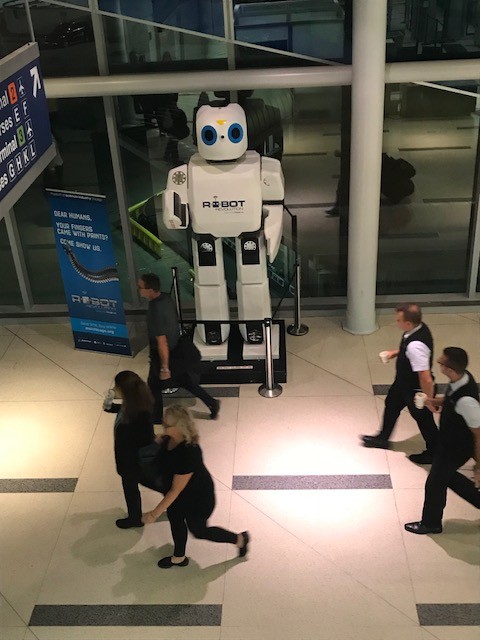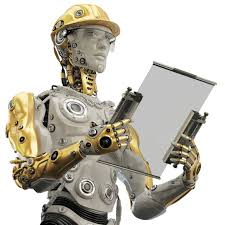Is it time to show love to the Robot?
It's late in the evening and I am at Chicago’s O’Hare Airport waiting on a flight.
As I look down at the throngs of people still milling around the airport, I notice that no one is paying attention to, or even noticing the giant robot, standing all alone in the terminal!
It’s about ten feet tall and four feet wide and part of a promotion by the Chicago Museum of Science and Industry.
Almost all those travelling at this time of the day are adults.
Then I see what was probably the only child in the airport, come running up to the robot and started engaging with it. He was about seven or eight years of age and he seemed to be having a lot of fun until his parents arrived on the scene and dragged him away from his fun.
All the adults seemed to be plugged into their phones or immensely distracted by whatever was going on in their world, while the child was curious as to what this amazingly shinny thing was and how he could play with it.
Perhaps it is because children are accustomed to seeing robots and interacting with them, as robotics and automation are part of their DNA, as they are growing up in a world that is vastly different from any previous generation.
In a world where in the not too distant future, robots will become part of our families, like our pets in our homes today!
Maybe it’s because children are also more naturally curious than adults and gradually over time we lose that curiosity.
According to the Museum of Science and Industry in Chicago our worldwide levels of curiosity are at an all-time low and our attention spans are shrinking.
Robots are increasingly becoming more prominent in our society and used in many different areas.
For example, they are being used to teach students in the classroom for a number of subjects across science, math and language. But according to a recent study, while students enjoy learning with robots, teachers are slightly reluctant to use them in the classroom.
It appears that the teachers were very skeptical of using robots, stating that they did not have confidence in their technical capabilities. There was also trust issues as the teachers were concerned that robots may eventually replace them (how many of us feel this way?).
Regardless of the concerns, we need to recognize that robotics is not intended to replace teachers but to enhance the experience in the classroom, to be used as learning aids.
By the way, I recently returned to the airport and that robot is still there, hopefully it has had a lot of love and attention in the meantime!
Is it time to start loving our robots?
John McGlinchey is the Executive Vice President of Global Certification for CompTIA
My son may never learn to drive
I was in a meeting recently and as we were chatting before the meeting formally started, one of my colleagues made the comment that her son will probably never learn to drive. He is five.
As much as I am connected to the technical revolution, I had never given any thought to that notion. Most of Generation Z will never learn to drive or if they can, they won’t have to, because of autonomous cars.
I did some research and came across this great post by Michael Kauffman, How Big Data Knows My Son Will Never Learn To Drive
Some are saying that it will be 2040’s before we see widespread adoption but considering Apple, Google, Uber are all exploring the technology of autonomous cars, the realization is that it will be sooner that we expect. As Bill Gates once said, “We always overestimate the change that will occur in the next 2 years and underestimate the change that will occur in the next 10.”
Kauffman goes on to say that the benefits for autonomous cars are so compelling, that all the major car manufacturers say they will offer autonomous cars by the 2020’s.
Consider also the safety aspect. Although some may shudder to think of the devastation that driver-less cars could impart upon us, there is evidence that it could be much safer - Autonomous cars are estimated to be 78% safer. This isn’t surprising when you consider that human error accounts for over 90% of road accidents. Indeed, autonomous cars may represent the single greatest improvement in automotive history.
There are very few drivers among us who have not experienced the stress of traffic jams, delays and stressful journeys to work or to a social event. Kauffman states that autonomous cars will greatly reduce traffic because they have such quick reflexes and could travel 8 times closer to each other on the freeway and still hit the brakes fast enough to stop safely when needed. So even if rush hour traffic is 8 times heavier than full speed free flowing traffic, you could potentially be moving much closer to full speed.
Driving can also be a great waste of time but autonomous cars will allow you to work, rest or even watch a movie while you travel.
So, you have your iPad, iPhone and iWatch and your next big purchase could be your iCar. Reports suggest that Apple is developing an electric iCar to rival Tesla.
In the same way that I think digital technology can never replicate the pure joy of placing your new LP on the turntable and touching the needle down and listening to that new album for the first time, there is nothing quite like putting your foot on the accelerator of a beautiful machine and heading for the highway!
It is quite possible that your son or daughter may never experience that wonderful feeling - I'm not quite sure how I feel about that!
Image used: The fantastic image I used at the top of this post is by talented Irish illustrator, Jon Berkeley who I believe is living now in Barcelona. Check out his website www.holytrousers.com
John McGlinchey is the Senior Vice President of Global Business Development & Products for CompTIA
It’ll be life, Jim, but not as we know it!
A big thank you to Jane Dickinson, another one of my valued colleagues at CompTIA for being my guest blogger this week.
John McGlinchey
I just lost my scarf in Harrods, the London department store.
Well, actually it was a snood, which, for those unfamiliar with the term, is a circular piece of fabric that one wears around the neck.
It must have slipped off my arm, either accidentally or otherwise, and, in the absence of a call from the pleasant chap in Lost Property, is gone forever.
First world problem, right?
Right. So, why the lingering mild emotions of annoyance and loss?
The annoyance almost certainly stems from the fact that carelessness like this just doesn’t happen to me. With every year that passes, I become more ordered and organized. I know where my stuff is. If I didn’t, it would slow me down.
I suspect you’re the same?
Most of us identify time as being our most precious resource and have taken up the challenge to see just how much we can do, see and achieve. We lead full lives and productivity and efficiency are key, enhanced by the systems, technology and services we choose to adopt.
The loss?
It was a warm, attractive snood. Is it replaceable? Indirectly, probably. Was it expensive? No, and certainly not in comparison to Harrods’ wares. So why the long face? I put it down to 1970s values. You work and save hard for what you have and hence those – albeit material – items have a certain value to you.
These thoughts, about how we work hard for what we have, led me to recall the most interesting and disruptive lecture I’ve had the privilege of hearing this year.
The talk was by the economist Paul Mason, at the 2016 CompTIA EMEA Member and Partner Conference.
Of the many thought provoking threads, the one that stood out related to how increasing automation will transform the way we live and work.
In itself, this topic is hardly groundbreaking. All of us, irrespective of age, can name new, transformative labor saving technologies or automations that have been impactful during our lifetimes.
However, Mason is not forseeing technological progress in a linear fashion, but on a scale that would see widespread automation of both blue and white collar jobs. He suggests that a third industrial revolution is nigh but may stall due to the fear of creating mass unemployment and the associated ‘psychological aimlessness’.
As I write, news hits that Japanese Insurance Company Fukoku Mutual is making 34 redundancies and replacing those staff members with IBM’s Watson.
An Oxford Martin School Study suggests that 47% of US jobs are at risk to automation by 2035.
The solution?
Mason and others assert that we should de-link work and wages. Everyone would be paid a universal basic income by the State and the average working day would be cut.
It was there that it hit me. As I imagine it must feel to a weathered workhorse on the precipice of retirement, NOT working, or certainly not anywhere near the extent we are used to in the early 21st century, seems really, really scary.
In that moment, I suddenly felt sympathy for the Luddites. It had been easy to malign them from the comfortable hindsight of my history class; King Canute-like as they attempted to stem the tide of industrial progress.
Contemplating change of this magnitude is mind blowing. How will we define ourselves? How will our values change? How messy could this transition be? And many, many other questions.
However, on reflection, perhaps we shouldn’t be afraid to take a leap into this unknown. Particularly if it transpires we have some ability to design it and one of the key outcomes will be more personal time.
As a wise ex-colleague used to say, we all need to take the time to stop and smell the flowers.
Mason outlines one potential future society. There are indisputably others. None of us have an infallible crystal ball, but societal change is as certain as taxes.
It’ll be life Jim, but not as we know it!
Oh, and if you come across a homeless, burgundy fake fur snood, please let me know…
Jane Dickinson is a Senior Manager in CompTIA’s Western European team. She works with schools, colleges and universities to help them offer internationally recognized IT industry certifications alongside their programs to enhance learner employability.
Business success 2014: Selecting the right technology
In my last blog post I championed the human being the most important element in the workplace. That view certainly hasn’t changed, but the technology deployed in the workplace is almost as essential as having motivated and driven staff. The two need to marry each other, without divorce!
A huge ongoing challenge in the workplace is managing data. Big data, metadata, ever-increasing data – it’ll not go away, so learn to manage it. Now and in the future, a real headache is loss of business data.Read more







